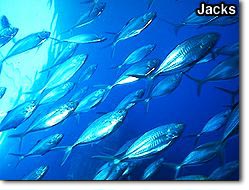CARANGIDAE Jacks, trevally, queenfish, and scad
 Body deep and moderately to highly compressed. Two dorsal fins, anal fin preceded by two separate spines, caudal fin deeply forked. Scutes sometimes present along lateral line. Jacks or trevally are powerful, strong-swimming fish which feed on other fishes, cuttlefish and crustaceans. Many of the species are large, free-roaming fish that gather around offshore structures and wrecks, and also in open water. Inshore reefs and creeks are home to smaller species such as the orange-spotted jack, Carangoides bajad . Body deep and moderately to highly compressed. Two dorsal fins, anal fin preceded by two separate spines, caudal fin deeply forked. Scutes sometimes present along lateral line. Jacks or trevally are powerful, strong-swimming fish which feed on other fishes, cuttlefish and crustaceans. Many of the species are large, free-roaming fish that gather around offshore structures and wrecks, and also in open water. Inshore reefs and creeks are home to smaller species such as the orange-spotted jack, Carangoides bajad .
Most species in this large family are overall silvery-grey in colour, with distinctive individual markings, including dark blotches, indistinct patches and black or orange spots. Carangidae swim in schools of a hundred or more fish, although larger species tend to be more solitary or hunt in smaller numbers. Alectis indicus, Alepes mate, Carangoides bajad , Carangoides chrysophrys, Carangoides malabaricus, Carangoides sexfasciatus, Gnathanodon speciosus, Megalaspis cordyla, Scomberoides commersonianus, Scomberomorus lysan, Seriola dumerili, Seriolina nigrofasciata, Trachinotus blochi, Ulua mentalis.
African pompano or threadfinned trevally Alectis indicus
Dark blue dorsally, black opercular spot, blunt high forehead. Dorsal and anal fin rays elongated in young specimens. Arabian Gulf and east coast on offshore reefs, around structures, and in open water. 100 cm.
Indian threadfinned trevally Alectis ciliaris
Silver-blue dorsally, silver below with black opercular spot, dorsal and anal fin rays elongated in young specimens. The young of this species have a striking appearance, with long filamentous rays extending from both the high dorsal fin and the leading edge of the anal fin. 90 cm.
Rainbow Runner Elagatis bipinnulatus
Bluish-green dorsally, silvery white with two blue stripes on sides; terminal two-rayed finlets to both dorsal and anal fins. Streamlined, powerful fish. Offshore pelagic: open water. Predatory on fishes, particularly mackerel, sardines, and occasionally cuttlefish and crustaceans. These torpedo-shaped fish have the appearance of giant fusiliers. Less common than kingfish, they are highly prized by sports fishermen. Seldom seen in the fish market, but increasing inshore in recent years. 90 cm.
Trevally Caranx sem
Bluish-green dorsally, silvery with numerous small orange spots. Offshore: deep-water reefs, wrecks, offshore structures. Predatory on fishes, and cuttlefish; predate on cigale during their vertigal migration in November and December for spawning. 90 cm.
Yellowfin jack Caranx ignobilis
Bluish-green dorsally, silvery with caudal fin dusky, except for pale leading edge. Highly curved lateral line. Extended leading edge to second dorsal and anal fins. Offshore: deep-water reefs, wrecks and other structures. Predatory on fishes, cuttlefish and crustaceans. 115 cm
Bigeye scad Selar crumenophthalmus
Bluish-green dorsally, silver, translucent sides; pale yellow band laterally. Large eyes set high on forehead. Slim caudal wrist and deeply forked tail. Arabian Gulf and east coast. Pelagic in large shoals, feeding on small fish and crustaceans. Shoals of these free-ranging, silvery fishes move close inshore and are often taken in nets by local fishermen. 30 cm.
Talang Queenfish Scomberoides commersonianus
Dark greeny-blue dorsally, bright yellowy-gold dorsally fading to silver and white underbelly. Five to eight large dark spots above lateral line. Scales oval shaped. Blunt head, large powerful jaws. 7 to 12 lower gill-rakers. Gulf and east coast, inshore reefs and creeks, also wrecks and offshore structures. Predator on fish, cuttlefish and crustaceans. While the kingfish is slim and elongate, queenfish are deep-bodied with powerful, crushing jaws and large eyes. 100 cm.
Queenfish Scomberoides lysan
Dark greeny-blue dorsally, with five to six parallel rows of dark spots either sides of the lateral line. Slim, streamlined shape, head mackerel-shaped. 15 to 20 lower gill-rakers. Gulf and east coast on inshore reefs and creeks, also wrecks and offshore structures. Predator on fish, cuttlefish and crustaceans. 100 cm.
|